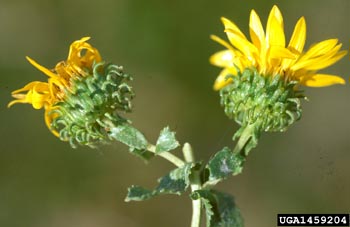Curlycup Gumweed

Common Name(s):
Curlycup Gumweed
Gumweed
Scientific Name:
Grindelia squarrosa (Pursh) Dunal
Scientific Name Synonyms:
None known
Symbol:
GRSQ
Description:
Life Span: Annual, Biennial, or Perennial
Origin: Native
Season: Warm
Growth Characteristics: An erect, tall forb, growing 1 to 3 feet tall, with 1 to several branched stems. Grows from a taproot, branching above. Starts growth in early spring, flowers July to August, reproduces from seeds.
Flowers/Inflorescence: Numerous and yellow. There are bracts at the base of the flower which are shiny, sticky, and curved downward (hence the name "squarrose" in the name). Fruit is an achene.
Fruits/Seeds: Fruit is an achene.
Leaves: Alternate and oblong with toothed edges, gland-dotted, and gummy.
Ecological Adaptions:
Curlycup gumweed favors dry areas, but grows on moist soils that lack other vegetation. It is most common in dry prairies, waste places, roadsides, railroads, depleted rangelands, and abandoned croplands. It often forms almost pure stands. It is found at elevations from 3,000 to 8,000 feet. Curlycup gumweed increases under drought conditions.
Soils: Curlycup gumweed does best on sandy loam, loam, and clayey loam, although it is adapted to a broad range of soils. It is tolerant of saline soils.
Associated Species: Rubber rabbitbrush, big sagebrush, western wheatgrass, and associated roadside weeds.
Uses and Management:
Curlycup gumweed is unpalatable to cattle, sheep, and horses, though sheep will occasionally crop flower heads in the absence of other forage. Tannins, volatile oils, resins, bitter alkaloids, and glucosides give it an unpleasant taste. If curlycup gumweed is consumed, it may lead to poisoning due to the selenium the plant can accumulate. It is resistant to grazing and drought.
American Indians used the gummy secretions of curlycup gumweed to relieve asthma, bronchitis, and colic. Pawnee Indians boiled leaves and flowering tops to treat saddle sores and raw skin. Today, medicinal uses include treatment of bronchial spasm, whooping cough, asthma, and rashes caused by poison ivy. Curlycup gumweed extract is valuable as a stimulant, sedative, astringent, purgative, emetic, diuretic, antiseptic, and disinfectant.

